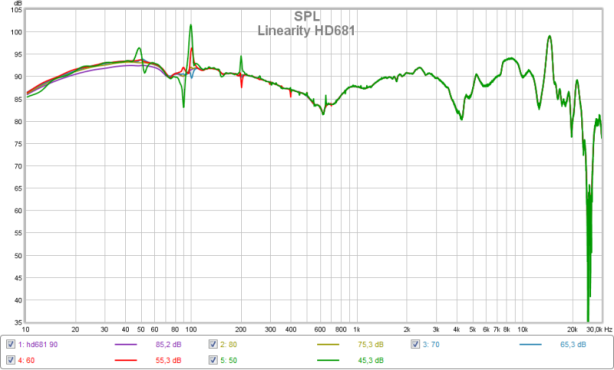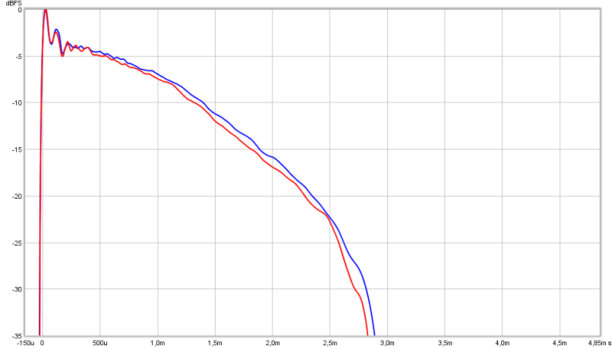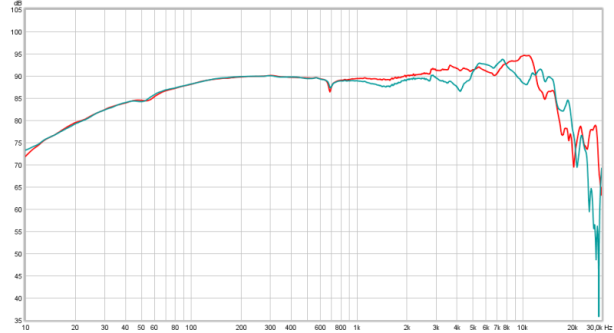SRH-1440
back to Shure
back to measurements
home
published: Jun-27-2020
NO SMOOTHING is applied to the shown plots. Most measurement sites have some smoothing applied which ‘irons flat’ sharp peaks and ‘wiggles’. I do not use smoothing because some info about sound quality is lost when plots are smoothed.
Aside from a small correction of the microphone itself also some correction in the lowest frequencies is applied to the plots to compensate for the perceived loss of bass when using headphones. This is described HERE in more detail.
A ‘horizontal‘ frequency response curve on the shown frequency response plots on this website thus indicates a perceived ‘flat’ tonal signature.
ALL measurements are made with a good SEAL on a flatbed measurement rig.
The shape of your head, bone structure, pad size, pad ‘softness, (compliance), hair or no hair and or wearing glasses may (drastically) change the frequency response of some headphones, so… your personal experience may differ substantially from these plots.
Frequency response (tonal balance) is the most sound-determining aspect of headphones. A horizontal line shows audible neutral response in the plots on this website. Deviations in different severities at different frequency bands have an effect on the sound character.
The bigger the deviation the stronger the effect.
Below an aid to help determining the sound character of headphones with relation to the frequency response.

Shure SRH-1440
The Shure SRH-1440 headphone is an open over-ear headphone. It has rather plastic look and feel. When adjusting the headphone all kinds of plastic creeks can be heard. Once in position it is O.K. The MSRP is around €350.-.
The rear of the driver remains hidden behind dampening cloth.
It looks a bit like a €200.- cheaper version of the SRH-1840. Shure doesn’t have much open headphones in their line-up so there is far less to choose than from the closed Shure offerings.
The measured headphone is used and was kindly sent in for measurements.
The headband can be adjusted in height. This is done by metal sliders. The part that touches the head consists of 2 thin pleather covered strips.
The pads are replaceable and made of velour. The SRH-1440 comes in a nice hardcase with a set of spare HPAEC1440 pads. The pads feel comfortable with plenty of room for most earsizes and shapes. There is no memory foam inside the pads.
The memory foam pads do feel soft and can provide a good seal.
The clamping force is average so there is quite some clamping force but not uncomforatble high. One can keep these headphones on the head for many hours.
The cups cannot swivel and tilt very far but just enough so they sit properly on my slightly smaller than average head.
The supplied cable is 2.1 meter. This length is quite suited for usage with desktop/home equipment and can also be used with portable gear in which case a shorter cable would be nice. It may be a bit short for listening in a comfy chair connected to a stereo system and a bit long for portable usage.
The cable has colour coded (red and black) gold-plated MMCX connectors. These connectors are also used in the Shure IEM models and the SRH-1540.
The cable is smooth and just slightly microphonic. There is 3.5mm TRS connector with a screw-on 6.3mm adapter. One can use this headphone on balanced amplifiers when using an aftermarket balanced cable.
With its 343 g (without cable) it is a normal weight headphone.
The efficiency is quite high and the impedance is quite decent (34Ω measured). This headphone will play well from most phones, tablets and DAPs. It is a lot more sensitive than the more expensive SRH-1840. It has a high power rating (1W) so you won’t blow it up easily when connected to a decent headphone amplifier.
specifications:
Type: Over ear, open
Usage: Home/studio
Driver type: dynamic
Pads: replaceable velour with regular foam.
Inner pad dimensions: height: 60mm, width: 40 mm, depth: 21mm.
Foldable: No
Headphone connector: MMCX connector, color coded
Cable entry: dual sided, split cable.
Cable: 2.1m smooth vinyl 3.5mm TRS + 6.3mm adapter
Driver size: 40mm, not angled
Power rating: 1W
Max. Voltage: 5.8 V
Max. current: 170 mA
Max. S.P.L. 130 dB
Impedance: 34 Ω
Efficiency: 101dB @ 1mW
Sensitivity: 116dB @ 1V
Weight: 343g, cable adds 40 g.
Clamping force: medium
Colour: black.
Accessories: extra pads, 6.3mm adapter, hardcase.
Sound description:
The SRH-1440 is light on the bass. Bass sounds realistic and very natural/realistic on well made recordings. With popular music the sound is cold and quite bass-shy lackin ‘body’.
The mids sound clear/bright but not emphasized. At higher listening levels the headphone can be a little shouty.
The treble sounds a bit elevated. Pinna gain can also add some level between 1kHz and 4kHz, which I do not measure which would make it even brighter than the plots show. There is enough treble but ‘sparkle’ is slightly lacking. There is a very slight but not disturbing ’emphasis’ on sss-ess but not s much one could call it sibilant. Just a slight unnaturalness/harshness in the treble.
This could be called a neutral and realistic sound just a touch light in the bass when one likes ‘Harman bass’ sound. For those enjoying jazz and classic music it is just about right.
The SRH-1540 is a better choice so when one can stretch the budget I would recommend to go for the SRH-1540 instead, at least when it must be a Shure headphone.
measurements
Below the frequency response of the SRH-1440 (Left, Right)
Channel matching is exemplary. Bass rolls off gently but a bit early from about 100Hz. Bass quality is quite good.
Another thing that stands out in these measurements is that there are no dips or peaks between 10Hz and 7kHz. This makes the overall sound really ‘natural’. There is a slight emphasis from 2kHz upwards which increases above 7kHz. Above 12kHz the output drops rather quickly. This small elevation combined with the lack of body/bass makes this headphone sound on the bright/thin side.
A good thing is that the treble does not have alarmingly high dips or peaks.
The specified 15Hz – 27kHz is indeed reached but at -10dB.
compared to
As most people are interested to see how it compares to other well known closed headphones. Below a couple of plots that show where they differ tonally.
Below the SRH-1440 versus the SRH-1840 which is the most logical comparison
The SRH-1840 has about the same bass extension and quality. Differences start to show above 1kHz. The SRH-1440 has a few dB more output and about 5dB in the ‘sibilance’ area (4kHz to 6kHz). Also above 8kHz the level is about 5dB higher.
This shows the bight character of the SRH-1440 compared to the SRH-1840.
Another headphone that is deemed to be bass-shy and bright is the DT880 Edition/Pro (the DT880 Black is a differently tuned headphone).
Below the SRH-1440 versus the DT-880 Edition
The DT880 has better bass extension and has much less ‘claity/presence’ is better extended on the treble and a more ‘relaxed’ listen
Below the SRH-1440 versus the HD600  The HD600 has better lows extension and presence. Even the HD600 is considered to be bass-light. The HD600 also has a few dB less clarity/presence as the SRH-1440. The SRH-1440 has about 5dB more ‘sharpness’ (10kHz) and is less well extended.
The HD600 has better lows extension and presence. Even the HD600 is considered to be bass-light. The HD600 also has a few dB less clarity/presence as the SRH-1440. The SRH-1440 has about 5dB more ‘sharpness’ (10kHz) and is less well extended.
Below the SRH-1440 versus the HD650 
The same story as for the HD600 above except there is more bass and bass extension and clarity difference is even bigger. Treble extension of the HD650 is also much better.
Below the SRH-1440 versus the HD660S  The HD660S has a few dB more bass and considerably less clarity and much better treble extension.
The HD660S has a few dB more bass and considerably less clarity and much better treble extension.
Below the SRH-1440 versus the K701/K702
Bass levels and mids are quite comparable. On average the treble levels of the K701 are about the same as well but the dip around 3.5kHz removes some of the shoutyness. Treble quality of the K701/K702 differs as well. The K701 is also considered bass shy and quite trebly.
Below the SRH-1440 versus the X2-HR
Those looking for an open headphone with a bit more bass/fullness and slightly less clarity could consider the X2-HR.
Seal
Seal can be an issue with closed-back headphones. Breaking the seal such as improper fit on the head, means a loss of (sub)bass. With open headphones the effect usually isn’t nearly as profound. Below the effect of different levels of seal breach are shown.
Perfect seal, seal broken with thick armed glasses, seal broken using a 6.3mm TRS plug. A perfect seal is not needed for this headphone. Using thick armed glasses won’t audibly affect the LF response of this headphone. Breaking the seal a bit further also does not influence the sound signature.
output resistance / damping-factor
As this is a dynamic headphone the frequency response might be amplifier output resistance dependent when certain higher output resistance amplifiers are used.
To test this the headphone is measured via a low impedance amplifier (0.2Ω) and a high impedance amplifier (120Ω). On a higher output resistance amplifier the output level will be 12.4 dB lower. To compensate for this the amplifier is cranked up to the same level (at 1kHz) as the low impedance amplifier. This way the plots are overlay-ed and it is easy to see how the tonal balance changes. 
This is one of those headphones that actually improves in sound quality when driven from a high output resistance (tube) amplifier. The sound gets a tiny bit more warmth/body.
Below the distortion measurements of the SRH-1440. Below the Left channel. The plot above is in a dB scale, below the same measurement but in a percentage scale.
The plot above is in a dB scale, below the same measurement but in a percentage scale. There is quite a lot of 3rd and 5th harmonic distortion (indicating compression) below 500Hz. 4% in the lows is reaching audible levels. This is measured at 90dB (slightly over 0.1mW). Above 500Hz the distortion is reaching low levels.
There is quite a lot of 3rd and 5th harmonic distortion (indicating compression) below 500Hz. 4% in the lows is reaching audible levels. This is measured at 90dB (slightly over 0.1mW). Above 500Hz the distortion is reaching low levels.
This prompted me to dig a little further (as I did with the HE-35X)
It looks like the SRH-1440 (and also the SRH-1840) are over damped which restricts airflow at higher SPL. Below some measurements to clarify.
First a linearity measurement for the Edition XX (ignore the 50, 100 and 200Hz spikes/dips = hum) What is shown above is the measured frequency response between 10Hz and 30kHz at different SPL. 95dB, 85dB, 75dB, 65dB and 55dB.
What is shown above is the measured frequency response between 10Hz and 30kHz at different SPL. 95dB, 85dB, 75dB, 65dB and 55dB.
The plot below is the same measurement but with all traces overlayed.
 What can be seen is that the frequency response is the same at all different levels.
What can be seen is that the frequency response is the same at all different levels.
This is the case for most headphones. Below the € 20.- Superlux HD681 for instance.
Here we see some slight compression at 92dB (between 30 and 60Hz)
Below the response of the SRH1440 at 98, 90 and 80dB SPL. Note: some EQ has been applied to take EQ in the bass into consideration And of coarse below the overlayed frequency responses.
And of coarse below the overlayed frequency responses.
As can be seen the shape of the response (bass relative to mids and treble) differs at different amplitudes. It isn’t alarmingly high but the effect is shown. This means at low listening levels there will be slightly more bass (about 2dB) than at higher listening levels. This is caused by non-linearities at higher excursions of the membrane. We hear it differently because of equal loudness contour effects.
Time domain measurements
Below the CSD of the SRH-1440 (Left and Right are superimposed) @ 90dB SPL. There are some very short lived and not sound degrading resonances visible at 3kHz. The lower mids decay pretty fast. Overall this plot shows a well damped headphone.
There are some very short lived and not sound degrading resonances visible at 3kHz. The lower mids decay pretty fast. Overall this plot shows a well damped headphone.
Another form of looking in the time domain is the spectrum plot. The amplitude is color coded and both the time scale and frequency scale differ as well.
Below the spectrum plot of the SRH-1440 (Right channel) 
Frequencies below 400Hz are well damped (a bit too much actually). There is some low amplitude resonance around 700Hz, 2.8kHz and 3.6kHz. The higher frequencies are well damped.
Below the step response with a dB scale (so not similar to an oscilloscope plot which has a linear scale). The step response (Left and Right channel over-layed) 
The part that is supposed to be horizontal drops down fast. This shows the bass-light character of the headphone. There is quite someovershoot and the slope is downwards from the rising edge. This shows the ‘peaky’ and overly clear/bright character of this headphone quite well.
Square-wave and impulse response
Below the 40Hz and 440Hz square-wave response as well as a 100μs DC impulse.
The upper traces are of the stock SRH-1440 and the lower traces when inserting 10mm diameter paracord/rope under the pads. The green trace is the applied signal and the ‘target’ the measured response should reach. Note: there is a timing difference caused by the speed of sound and driver-mic distance.
The green trace is the applied signal and the ‘target’ the measured response should reach. Note: there is a timing difference caused by the speed of sound and driver-mic distance.
The paracord/rope mod (see below) not only increases room for the ears but also lowers overshoot/brightness a bit leading.
The SRH-1440 driver is damped quite well given the 440Hz and needle pulse response/ringing.
paracord/rope modification
Stuffing a spacer under the SRH-1440 pads will add 10mm more room for the ears so they don’t touch the driver. The owner included 24cm of this 10mmØ rope (per side) and wanted to know what effect it really has. 
Some claim bass would increase bass response and make the SRH-1440 less bright.
Below the actual effect of this rather simple and reversible modification. As can be seen bass levels do not change at all. Because of the driver-ear distance increasing the part above 1kHz becomes more neutral/less bright. The treble ‘sharpness’ around 10kHz is lower but between 5kHz and 9kHz (the sibilance area) the level is a bit higher.
As can be seen bass levels do not change at all. Because of the driver-ear distance increasing the part above 1kHz becomes more neutral/less bright. The treble ‘sharpness’ around 10kHz is lower but between 5kHz and 9kHz (the sibilance area) the level is a bit higher.
The tonal balance thus changes for the better (less bright) and treble differs a bit as well.
The downside of this modification is that the ‘flap’ holding the pads onto the cups are being pulled upon which, over time, will lead to pads falling off easily.
summary
The Shure SRH-1440 is a quite clear and bright sounding headphone that will be bass-shy on most pop-recordings. With orchestral and well recorded jazz and blues the sound will be clear and maybe a bit shy of ‘body’ but otherwise nice sounding.
Comfort is quite good.
Downsides are the plastic ‘feel’ and creaky hinges when adjusting the headphone.
There are alternatives for this headphone. In the Shure stable the about 1.5x more expensive SRH-1840 may well be a better choice.
With aftermarket cables this headphone can be driven balanced. Given it’s low impedance and efficiency there isn’t much point in balanced tough unless the balanced output comes from an USB dongle or small DAP.
